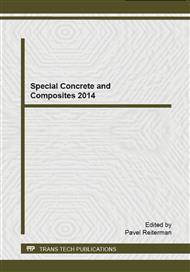p.1
p.6
p.11
p.17
p.22
p.27
p.33
p.37
p.43
Influence of Ceramic Fibers on Mechanical Characteristics of Refractory Composites
Abstract:
New and unexpected way of using cement composite in industrial sectors represents a current challenge for many research teams all over the world. Following contribution deals with the study of fiber-cement composite ́s mechanical properties after exposure to high temperature. This composite could be used for industry applications or for fire-resistance cladding production. Tensile strength in bending, compressive strength, bulk density and dynamic modulus of elasticity were examined on samples 40 x 40 x 160 mm. All parameters were measured before and after exposure to high temperature in electric furnace. One group contained three specimens was reference, without temperature load, the second group was exposure to 600 °C and the last one to 1000 °C. High aluminous cement Secar®71 works as refractory binder and nature crushed basalt aggregates two fractions works as filler. The composite ́s matrix was supplemented by various amounts of ceramic fibers. Especially the influence of amount of fibers on final properties was the main goal of this research. Measured mechanical parameters provide deep knowledge of their behavior after temperature on 1000 °C level. The compressive strength and tensile strength in bending achieved values 1.5 MPa. Behavior of the composite during and after temperature load was without any negative phenomena such as explosive spalling, cracks in aggregates or cement paste and macro disintegration of the composite ́s structure.
Info:
Periodical:
Pages:
22-26
Citation:
Online since:
October 2014
Authors:
Price:
Сopyright:
© 2014 Trans Tech Publications Ltd. All Rights Reserved
Share:
Citation:


